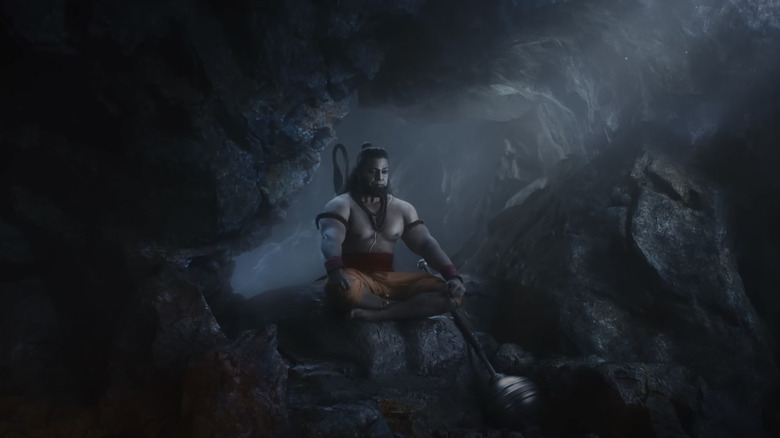Adipurush Will Be Bollywood's LOTR (& Western Audiences Better Get Prepared)
When Western audiences consider Bollywood (or Indian cinema as a whole), they're immediately drawn to the country's abundant portfolio of melodramatic romantic comedies or its vast array of potboiler masala thrillers. While Bollywood will forever be known for its lavishly designed and musical-oriented films, recent years have seen audience tastes and expectations shift. A culturally rich and geographically diverse country that has shifted at the hands of dozens of rulers, India has always found ways to celebrate itself through cinema. Historical dramas like the Rajupt dynasty-focused "Padmaavat" have become favorites for Western viewers, peeling back the layers on the country's various ruling dynasties and their various existential (and often romantic-related) anxieties.
As India's economy and film industry continues to grow, so does its aspirations. While grounded historical dramas cost a pretty penny, they pale in comparison to the price tags associated with fantasy films. Luckily, recent investments in VFX artists and studios have made it possible for creatives to tap into the country's rich mythology, finally having the means to give complex, visually bold ideas justice on the big screens. Thanks to high production values and visual effects that try to rival those of Hollywood blockbusters, mythological and fantasy-centric films like "Brahamastra" and "Baahubali" have become phenomena, paving the way for future Indian blockbusters.
What's India's biggest gamble? Om Raut's "Adipurush," a mythological epic based on the "Ramayana," a text considered to be one of the nation's most sacred. As one of the most expensive Indian films ever made, "Adipurush" has what it takes to be one of the country's most important cinematic exports. For many, "Lord of the Rings" was their first step into the world of fantasy — here's hoping "Adipurush" can be a gateway into Indian mythology for those in the West.
Adipurush isn't the first adaptation of the Ramayana, but it's certainly the biggest
"Adipurush" is setting itself up to be one of India's biggest films. With a budget north of $60 million USD, the mythological epic boasts a price tag few get. However, the creatives seem far more interested in the film's potential influence on the culture. "Adipurush" is an opportunity to tell the nation's most significant and impactful story in a grand, epic manner.
Written by the venerated poet Valmiki, the "Ramayana" has been the blueprint for traditional Indian storytelling for thousands of years. For South Asians around the world, it holds the same cultural weight as Homer's "Odyssey" or "Iliad." The Sanskrit epic follows the all-powerful, bow-and-arrow-slinging Lord Rama, who is exiled from the kingdom of Khosla. His wife, Sita, is ultimately kidnapped by the King of Lanka, Ravana. The ten-headed Ravana's capture of Sita leads to Rama teaming up with Hanuman, a monkey-humanoid, to strike Lanka and save Sita.
Penned thousands of years ago, "Ramayana" continues to be a source of inspiration within the Indian subcontinent. The epic has been adapted dozens of times, which each creative putting their own spin on Rama's story — something "Adipurush" acknowledges in its opening minutes. With "Adipurush," audiences around the world are getting the full-scale, fantasy-like treatment that the source material demands. While some South Asian audiences have found the film's narrative choices to be dubious, "Adipurush," which roughly translates to "First Man," is exposing Western audiences to a mythological text that isn't Euro-centric. Just as "Lord of the Rings" is influenced by Christianity, Hinduism is the backbone of "Adipurush." The hope is that it can expose millions to familiar themes such as good and evil through a drastically different cultural lens.
Western audiences are ready for inherently Indian stores like Adipurush
Like traveling, international cinema has the ability to open up the viewer's mind, exposing them to new, idiosyncratic, and culturally-focused ideas and themes that help expand their worldview. "Parasite" director Bong Joon-ho said it best during his Golden Globe award speech: "Once you overcome the 1-inch-tall barrier of subtitles, you will be introduced to so many more amazing films." While Chinese, Russian, and other Middle Eastern audiences have always enjoyed India's cinematic musings, it's only recently that Western cinephiles have started their love affair with the country's films.
It was S. S. Rajamouli's Telugu film "RRR" which drastically opened the floodgates for American and Canadian audiences to embrace Indian cinema. As conversations sorrounding the impact of colonialism continue to grow in the West, it makes sense that a film brutally shutting down the British Raj's rule became a phenomenon. While heavy subject matter helped pique curiosity, it was the film's unapologetically Indian execution that made it an instant classic. It built upon themes and ideas that are inherent to the nation's pop culture, such as the power of brotherhood and the Indian people's ability to rise up.
The same can be said for this year's "Pathaan," a "Mission: Impossible"-style spy-thriller that still managed to show off its Indian identity, preaching the perils of nationalistic chauvinism. Both films, which racked up over $15 million stateside (outgrossing several 2023 Best Picture nominees), spoke to Western audiences because of how they tackled and depicted South Asian issues and stories. If Western audiences can accept these vivid and rich blockbusters that comment on inherently Indian issues, they can finally embrace projects like "Adipurush," which adapts the foundation of South Asian storytelling.
Haters will always hate but the industry is rooting for Adipurush
Amidst all the backlash the film has received for its less-than-stellar visuals and depictions of the deities, the film is undeniably emerging as a force for good. Prior to the film's release, veteran Indian producer Abhishek Agarwal pledged that he would give away over 10,000 tickets to the film in the state of Telangana for free. Tickets were distributed to public schools, orphanages, and several other institutions. This sparked a national trend, with Bollywood superstar Ranbir Kapoor giving away a similar amount of tickets to underprivileged children.
Indian creatives aren't just interested in helping the film recoup its cost — they want it to succeed so more stories based on Indian mythology can manifest. India continues to grow as a viable market for Hollywood epics, with films like "Avatar: The Way of Water" and "Avengers: Endgame" making over $59 million each in the country. Directors and stars in the country are taking note, hoping that those dollars can instead be pivoted towards homegrown, large-scale epics.
"Adipurush" might just be the most controversial project of the year, with particular criticism being hurled at the film's pacing and narrative choices. This is potentially a good thing, as Indian creatives are known to take notes from the audience ("Adipurush" famously pulled a "Sonic" and delayed itself by a year to improve its VFX — a commendable effort, since proven to be moot). Viewers have made it clear that they don't appreciate how "Adipurush" depicted Lord Ram and Raaavan, so now it's time for future writers and directors to take that feedback into account for future projects based on Indian mythology and religion. And per the film's record-breaking opening weekend gross, it's obvious that more films based on these deities are coming.
Adipurush's success will kickstart a trend of mythology films
While "Adipurush" has received mixed reviews, it's difficult to ignore the conversation that the film has stirred up. The Om Raut-directed film comes at a time where pop Indian cinema is grappling with its future as a hopeful powerhouse. Critics have dubbed it a swing and a miss that fails to capture the epic nature of the "Ramayana," while general audiences have less than positive things to say about the project's visual language. That said, it's notable how rather than churn out rip-offs of Hollywood or South Korean cinema, Indian creatives are taking big risks to create unique works that define their nation on their own terms.
"Adipurush" isn't a failure — it's set to be one of the most financially promising films of the year both in its native country and stateside –but most importantly, it does plant the seeds for South Asian storytellers to confidently tell their own fantasy stories. Audiences may be displeased with how the film handled the "Ramayana," but they did help propel "Adipurush" to the top of the box office, where it grossed over 300 crore in its opening weekend. And if "Lord of the Rings" paved the way for a resurgence of fantasy films in Hollywood, then "Adipurush" could be the first of many Indian-centric mythology films.
Bollywood is already planning more films based on the "Ramayana" — " Heart of Stone" star Alia Bhatt and Ranbir Kapoor have already been roped in for an adaptation spearheaded by Nitesh Tiwari. Only time will tell if that take on Sita and Rama's journey will become the definitive live-action version of the "Ramayana." For now, whether audiences like it or not, it's "Adipurush."




